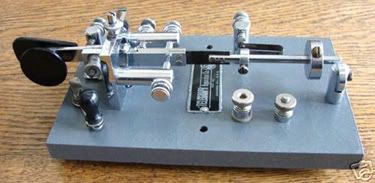While my wife would say that I consider all my code keys “keepers,” the key that arrived today comes near the top of that list.
It's not particularly rare, but its one of those keys that collectors seem to chase — the Telegraph Apparatus Co. CP-510 semi-automatic key, otherwise known as the “Hole-in-the-wall” bug.

The Telegraph Apparatus Co. was a joint effort between world champion telegrapher Ted McElroy and the Hallicrafters Co. of Chicago. The company began producing bugs destined for war use by about 1943.
McElroy's Boston, Mass., company produced his Mac Key bugs from 1934 to about 1942. The company received numerous military contracts for telegraphy equipment — high speed encoders/decoders and training equipment among them. His line of Mac Key bugs came to end in 1942.
That's when TAC began production of keys The hole-in-the-wall bug was available to the public in a standard model (with a painted base) and a deluxe model (chrome plated base). During the war, TAC also produced a Vibroplex clone. I've only seen a couple of these, and they appear to be in high demand.
My new CP-510 joins the two other TAC bugs in my collection. Both of these are deluxe models, though the chrome plated on the base of one of them is in bad shape. The new one actually is the best of the three, having been restored by the collector who sold it. It really looks like a brand new key, too.
The TAC bugs are interesting because they have a wider speed range (i.e., slower) than most Vibroplex bugs. The main spring is longer on the TAC bug, and my theory is the longer spring gives it a more gentle action. If you move the weights forward, it'll run as fast as you like. For a non-jewel movement bug, it's surprisingly how good a feel it has.
The drawback to the “hole-in-the-wall” bug is the base. This key is a full 4 inches wide, though it seems much wider. On the operating desk it feels like I'm sending CW with a trunk lid (ok, I'm exaggerating, but it just feels as though it takes a lot of desk space).
EBAY MUSINGS. I missed out on one of the rarer Vibroplex keys overnight … a Vibroplex Zephyr sold for a bargain price of $80. The auction ended in the wee hours of a Thursday morning, which probably explains the low sale price. Zephyrs are often misidentified by sellers because of their similiarity to the Champion model.
There are just two differences between the Zephyr and the Champion; the Zephyr's base is a 1/2-inch narrower, and it has a circuit closer. That's it.
Now imagine its 1940 and you're shopping for a code key to reward yourself for earning that Class A ticket. You want a Vibroplex key, sure, but which model? The Champion is the value leader and most affordable. The Original DeLuxe is the most expensive (about $7-9 separate the two).
But there's also the Lightning Bug, which is available in standard and deluxe models, just like the Original; in fact, the prices are the same for the Original and Lightning Bug models. And don't forget the Blue Racer, also available in standard or deluxe models.
The Champion and Zephyr are available only with painted bases (in 1940, the color was black); the Zephyr — which looked nearly identical to the low- priced Champion — was priced the same as the Vibroplex Original.
For consumers, it appeared as though they were paying the “Cadillac” price for a “Chevrolet” key. The main visible difference was the circuit closer. As you might expect, most buyers willing to shell out $17 for a key chose the Original or Lightning Bug keys. The Zephyr was quietly discontinued — and thus they are fairly hard to find today.
KEY PRICES. Overall the demand for keys seems to be steady, judging from prices. It's amazing to see J-38s selling for such high prices too. A mid-1960s Vibroplex Original DeLuxe in good shape topped $150, a high price for a not-so-rare key. Still, it's lower than retail, and you gotta love all that chrome, hi!
I've sworn off additional eBay purchases for the time being, preferring instead to have some pocket change for the hamfests coming up soon. I'll be looking however, as there are some really nice keys currently listed, and even watching how the auctions progress is better entertainment that American Idol. Perhaps eBay-watching is my own ham radio version which I've dubbed “American Idle” (or should that be “Idle American”??).
I better go practice my bid sniping, need to stay in shape. 73 … de KY4Z … dit dit ….
